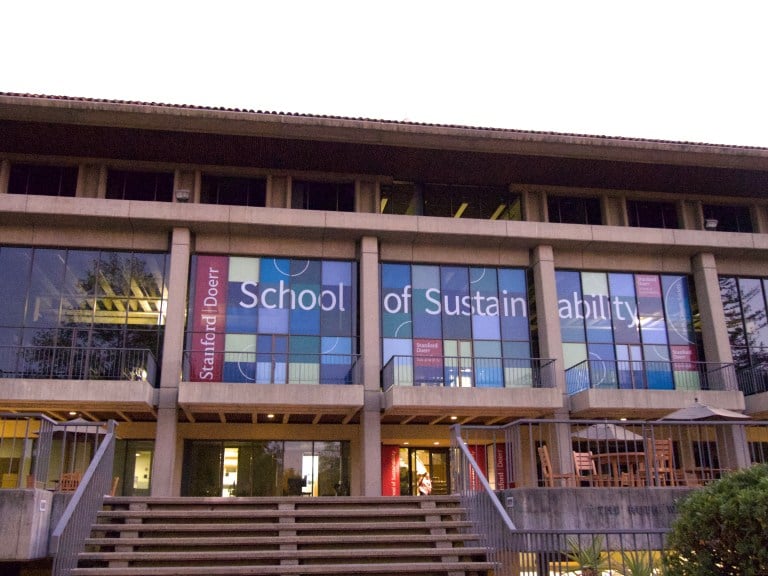Nearly a year after the Stanford Doerr School of Sustainability (SDSS) named greenhouse gas removal as its first Flagship Destination — an ambitious goal that could have global impact — it announced the first 16 projects to receive grants.
Announced last month, the initiative is primarily coordinated through the Sustainability Accelerator, which supports faculty-led projects aligned with the Flagship Destination’s goal of removing greenhouse gasses at the gigaton scale by 2050.
In the 2015 Paris Agreement, 196 states committed to attempting to cap the global temperature increase at 1.5 degrees Celsius above pre-industrial levels, according to the IPCC.
One way to reduce global warming is to decrease greenhouse gas emissions. However, Simon Stiell, Executive Secretary of U.N. Climate Change, said in a United Nations press release that the group of countries, “are still nowhere near the scale and pace of emission reductions required to put us on track toward a 1.5 degrees Celsius world.”
Seeking more aggressive methods to achieve the Paris Agreement’s goal, greenhouse gas removal (GHG-R) is a possible strategy. GHG-R is the process of actively removing greenhouse gasses that have already dissipated in the atmosphere.
Typically, GHG-R uses chemical reactions to extract carbon dioxide (CO2) from the air. The captured CO2 can then be stored deep underground or repurposed for applications like making aviation fuel or concrete. Currently, the world’s largest GHG-R facility, Orca, located in Iceland, can capture 4,000 metric tons of carbon annually. However, according to the Environmental Protection Agency’s Greenhouse Gas Equivalency calculator, this amount is only equivalent to the emissions generated by around 504 homes’ energy usage.
GHG-R’s whopping cost is the most significant obstacle to pulling CO2 from the air. According to the University of Pennsylvania’s Kleinman Center of Energy Policy, the current cost of GHG-R ranges “from $400 to $1,000 per metric ton of CO2 removed.” In contrast, natural methods like reforestation and biochar typically cost less than $10 per ton of CO2 removed, as reported by Natural Academics. While GHG-R costs are indeed decreasing, further reductions are essential for it to be widely adopted and scaled.
According to the Doerr School’s announcement, the Accelerator’s projects aim to create more innovative GHG-R technology, employing diverse strategies like enhanced weathering, seaweed cultivation and harnessing earthworms to capture CO2.
Doerr School Spokesperson Mara Vandlik said that projects were chosen by a selection committee based on a number of criteria, including their potential impact, novelty and partner strategy. Vandlik emphasized the potential for cross-sector collaboration in these projects, with the grants also providing access to “customers, policymakers and investors, networking and ecosystem building to accelerate their progress.”
Earth system science professor Kate Maher serves on four of the 16 project teams and is especially excited about the connections these projects can foster.
“We come in much more on the technical side, and it’s been such a neat opportunity to work with people on the finance and policy side. I think [collaboration] will grow as the projects start to connect.”
The Doerr School has not been met with all praise. Since its opening in 2021, the Doerr School has faced criticism for receiving funding from fossil fuel giants like ExxonMobil, Shell and TotalEnergies.
Several initiatives have voiced their concerns with the Doerr School, including the activist group Coalition for a True School of Sustainability, which calls upon the Doerr School to sever ties with fossil fuel companies.
When asked why accepting funding from fossil fuel companies is problematic, Amanda Campos ’26, a coalition member, said, “We’re talking about hundreds of millions of dollars every year against climate legislation and then we’re collaborating with them on climate energy research. There is a fundamental disconnect.”
Campos suggested that the Flagship Destination of greenhouse gas removal is problematic, given its alignment with the interests of fossil fuel companies. She noted that this strategy doesn’t directly address the reduction of CO2 emissions, but rather relies on extracting it from the atmosphere later on.
“Companies are spending millions and millions on [carbon capture removing technology] as opposed to clean energy, as opposed to offshore wind, as opposed to so many other clean technologies that can be scaled up and turned into research but would dismantle the fossil fuel economy that we have today,” Campos said.
Campos cited The Intergovernmental Panel on Climate Change, which concluded in its latest assessment report that while carbon removal is critical, so is reducing CO2 emissions before they enter into the atmosphere.
When asked if accepting funding from fossil fuel companies may conflict with the school’s goal of sustainability and potentially undermine the projects, Doerr Schoolspokesperson Mara Vandlik commented that they “recognize this is an impassioned topic for members in our community, and the university and [the Doerr School is] approaching this matter with the seriousness and rigor it deserves.”
Vandlik also noted the establishment of the Committee on Funding for Energy Research and Education, which was announced in 2022 to investigate and address the concerns raised against the Doerr School. It involves individuals from various backgrounds and roles, including incoming Stanford University president, Jonathan Levin ’94.
Campos called for Stanford to balance the need for financial support with ethical considerations and cut ties with fossil fuel companies.
“I think that first step is crucial, and it takes bravery, but I think that’s the whole point of being a groundbreaking institution and leading in this space,” she said.
This article was updated to correct the year the Committee on Funding for Energy Research and Education was announced. The Daily regrets this error.
